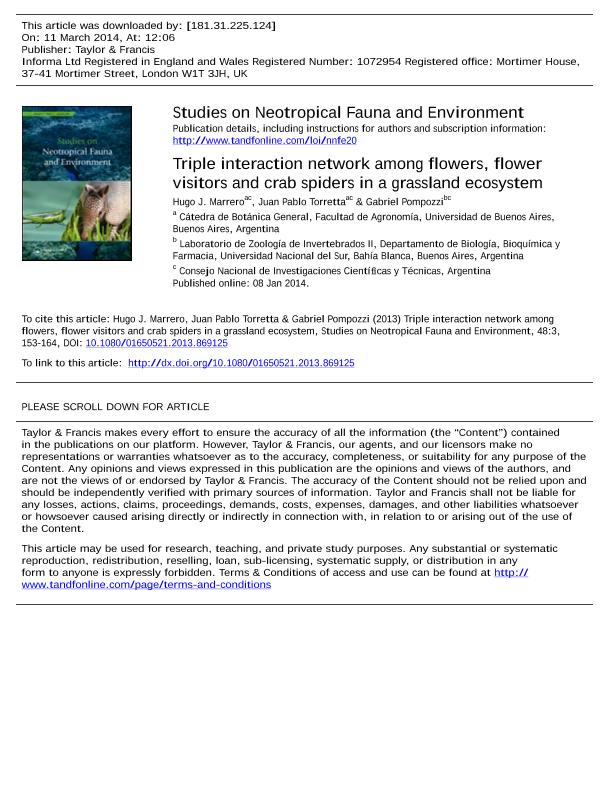Mostrar el registro sencillo del ítem
dc.contributor.author
Marrero, Hugo Javier

dc.contributor.author
Torretta, Juan Pablo

dc.contributor.author
Pompozzi, Gabriel Alejandro

dc.date.available
2017-07-31T20:47:41Z
dc.date.issued
2013-12
dc.identifier.citation
Marrero, Hugo Javier; Torretta, Juan Pablo; Pompozzi, Gabriel Alejandro; Triple interaction network among flowers, flower visitors and crab spiders in a grassland ecosystem; Taylor & Francis; Studies on Neotropical Fauna and Environment; 48; 3; 12-2013; 153-164
dc.identifier.issn
0165-0521
dc.identifier.uri
http://hdl.handle.net/11336/21662
dc.description.abstract
This study presents the first description of a tri-trophic interaction network with crab spiders as predators. Monthly observations of flowering entomophilous plant species were recorded between December 2009 and March 2010 and their flower visitors and predators (crab spiders) were caught, with or without prey. Moreover, flower visitors of different Orders were caught to evaluate the amount of pollen transported. In order to analyze changes in the plant species and crab spiders, we evaluated the interaction networks in which we had removed different Orders of prey (Hymenoptera, Diptera and Lepidoptera) from the original network. Our results indicate that crab spiders select their preys within the community. Furthermore, the Hymenoptera carried higher pollen loads and was the less frequent prey. When the Diptera preys were removed from the initial interaction network, network changes mainly affected the species richness of crab spiders. Decrease in density of Diptera, could increase plant resources useful for flower visitors carrying great pollen loads and could promote pollination. Crab spider preys might be restricted to only the more vulnerable flower visitors (e.g. smaller dimensions, without sting or with delicate cuticula) which consume resources and are inefficient as pollen carriers. The selected predation could not negatively affect the fitness of plants.
dc.format
application/pdf
dc.language.iso
eng
dc.publisher
Taylor & Francis

dc.rights
info:eu-repo/semantics/openAccess
dc.rights.uri
https://creativecommons.org/licenses/by-nc-sa/2.5/ar/
dc.subject
Tri-Trophic Interaction Network
dc.subject
Pollinator Prey
dc.subject
Triple-Interaction
dc.subject
Crab Spiders
dc.subject.classification
Conservación de la Biodiversidad

dc.subject.classification
Ciencias Biológicas

dc.subject.classification
CIENCIAS NATURALES Y EXACTAS

dc.title
Triple interaction network among flowers, flower visitors and crab spiders in a grassland ecosystem
dc.type
info:eu-repo/semantics/article
dc.type
info:ar-repo/semantics/artículo
dc.type
info:eu-repo/semantics/publishedVersion
dc.date.updated
2017-07-28T17:51:59Z
dc.journal.volume
48
dc.journal.number
3
dc.journal.pagination
153-164
dc.journal.pais
Reino Unido

dc.journal.ciudad
Londres
dc.description.fil
Fil: Marrero, Hugo Javier. Universidad de Buenos Aires. Facultad de Agronomía. Cátedra de Botánica General; Argentina. Consejo Nacional de Investigaciones Científicas y Técnicas; Argentina
dc.description.fil
Fil: Torretta, Juan Pablo. Universidad de Buenos Aires. Facultad de Agronomía. Cátedra de Botánica General; Argentina. Consejo Nacional de Investigaciones Científicas y Técnicas; Argentina
dc.description.fil
Fil: Pompozzi, Gabriel Alejandro. Universidad Nacional del Sur. Departamento de Biología, Bioquímica y Farmacia. Laboratorio de Zoología de Invertebrados II; Argentina. Consejo Nacional de Investigaciones Científicas y Técnicas; Argentina
dc.journal.title
Studies on Neotropical Fauna and Environment

dc.relation.alternativeid
info:eu-repo/semantics/altIdentifier/doi/http://dx.doi.org/10.1080/01650521.2013.869125
dc.relation.alternativeid
info:eu-repo/semantics/altIdentifier/url/http://www.tandfonline.com/doi/abs/10.1080/01650521.2013.869125
Archivos asociados
